Please Take Note: This is a review of the final game, but it might change slightly based on the success of the Kickstarter campaign. The game is being reviewed on the components and the rules provided with the understanding that “what you see is not what you might get” when the game is published. If you like what you read and want to learn more, we encourage you to visit the game’s website or visit the Kickstarter campaign. Now that we have all that disclaimer junk out of the way, on with the review!

The Basics:
- For ages 9 and up (publisher suggests 12+)
- For 2 players
- Approximately 45 minutes to complete
Geek Skills:
- Active Listening & Communication
- Counting & Math
- Logical & Critical Decision Making
- Reading
- Pattern/Color Matching
- Strategy & Tactics
- Risk vs. Reward
- Hand/Resource Management
Learning Curve:
- Child – Easy
- Adult – Easy
Theme & Narrative:
- Lead your faction to victory and power to restore order – your order – to the chaos
Endorsements:
- Gamer Geek mixed!
- Parent Geek approved!
- Child Geek approved!
Overview
Peace and prosperity was delivered across the galaxy through the space lanes. Ideas and resources were exchanged and cultures benefited from each other. There was no “mine” back then, only “ours”. That time has passed. When the space lanes collapsed, so too did intergalactic civilization. Now the individual systems and planets are alone in the endless vacuum of space and cutoff. Reason and logic have been replaced by panic and fear. Now is your time to rise and restore order at any cost.
NOVUS, designed by Damien Lavizzo and to be published by Zenion Games, will reportedly be a non-collectible card game comprised of 4 preconstructed faction decks. Each deck will contain 52 cards. Two cards in every deck will be a faction specific Commander with the remaining cards being faction specific and neutrals (non-faction aligned). As this is a review of a prepublished game, we will not comment on the game component quality. We will, however, happily talk your ear off about the proposed artwork that is going to be included in the final game. Simply stunning, imaginative, and strengthens the game’s theme and narrative beautifully. Not included in the game, but necessary to play, are counters to be used to track specific conditions and changes to cards whilst playing. We suggest a small collection of tokens and a set of 10-sided die for each player.
Please note that we were only provided 2 faction decks of the same faction to play with. Specifically, the Enthirian Collective which is a faction of super soldiers who have turned on their masters. We cannot comment on how the other factions might play or how each faction stacks up against one another. Due to the lack of available cards, we were unable to create a unique deck to test the deck building aspect of NOVUS. What follows is a fairly detailed high-level, but limited, summary of the game. Without having more of the game, we couldn’t go any further than what is provided below. Sorry about that…
Game Set Up
Note: NOVUS comes complete with preconstructed decks that can be played with right out of the box. This leaves little for the players to do when it comes to game set up. We discuss how a player can personalize their deck, but this will not change the game set up steps.
To set up the game, first have each player decide which Commander they will be using for the game and have them set it, face-down, in front of them and to their immediate left. When both players have placed their Commander cards, reveal them by flipping them over. The area where each player has their Commander card is referred to as the “Commander Zone”. Place any unused Commander cards back into their respective card boxes.
Second, each players shuffles their deck of 50 cards and allows their opponent to cut their deck. When completed, this is the player’s draw deck for the duration of the game. The draw deck should be placed to the player’s right. The area where each player has their draw deck is referred to as the “Deck Zone”.
Third, place any counters that will be used to one side of the game playing area and use some counters to set each player’s current Commander card’s morale value. As the game progresses, players should continue to play the game using the following as a guide to where cards are played and placed.
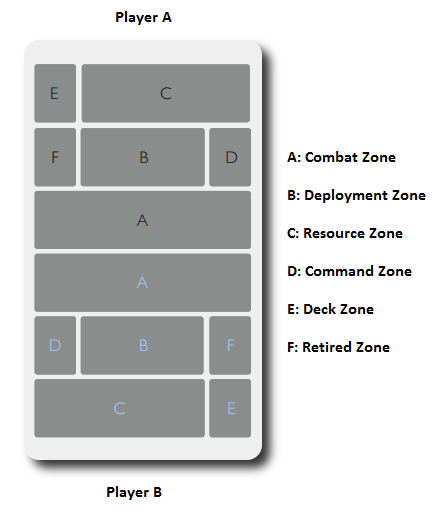
That’s it for game set up. Determine who will go first and let the battle for the future begin!
A Quick Inspection of the Troops
NOVUS is comprised of 5 different card types. These are Commander, Character, Location, Strategy, and Tactic. Each card type is briefly summarized here.
Commander Cards
The Commander cards represent the most talented and influential individuals in the war the players are waging. If might help to view the Commanders as the most elite of elite generals that are up front and leading the charge on behalf of the player. As such, they are exceedingly powerful and the most important card the player has. If the Commander fails, so too does the player’s cause. Only one Commander card can be used per game which determines what faction the player can use in the deck (other than neutrals) and strongly suggests what types of strategy and tactics the player should use during the game. Commander cards have a red border.
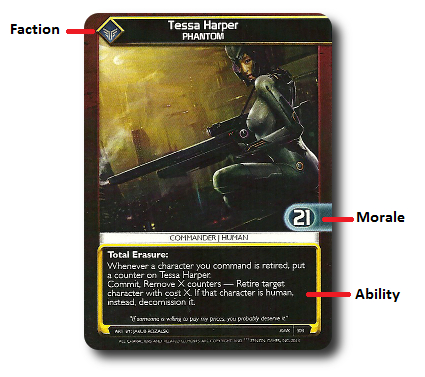
Character Cards
The Character cards represent the many individuals that have rallied to the player’s cause and follow the Commander without question. Each faction will have their own specific Characters with unique abilities and powers which can be further strengthened by the armed forces of neutral parties. Since Characters are the ones doing all the hard and dangerous work, they have an attack and defense value that is used when combat occurs. Character cards have a blue border.
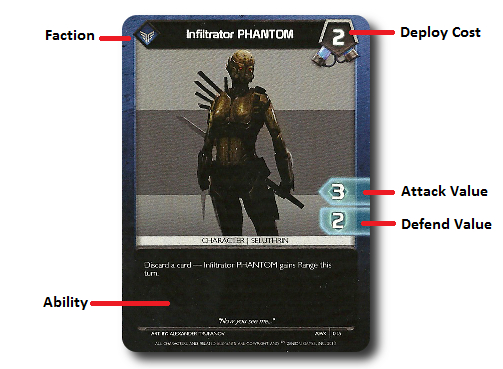
Location Cards
The Location cards represent important strategic and tactical areas that can be used to stage assaults or provide necessary infrastructure to further power the player’s war machine. Depending on the Location card, it can provide additional resources and special effects. Location cards have a yellow border.
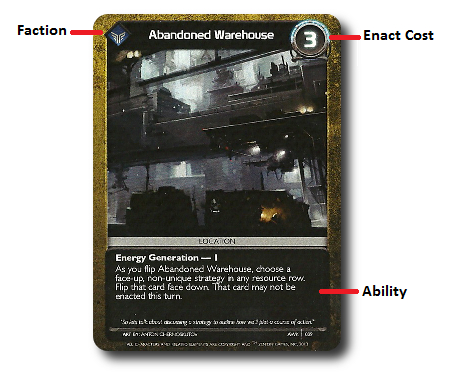
Strategy Cards
The Strategy cards represent long-term plans the player has initiated. Think of these as accessible abilities that are always at the ready, but await the player’s orders to be executed. Strategy cards have a green border.

Tactic Cards
The Tactic cards represent small, but essential, changes to the player’s overall strategy. They are meant to surprise the player’s opponent and be resolved quickly in hopes of providing the necessary edge to win the game. Tactic cards have a violet border.
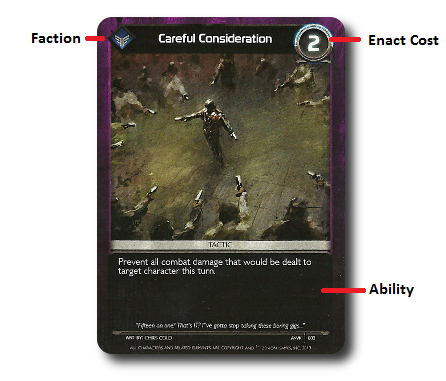
War Games
NOVUS is actually a very straight forward game to play. The game is played in turns with each player taking specific steps per turn during phases. The complexity of the game comes in knowing what cards to play and when. But even then, all cards are useful in the game because they are, by default, a resource. This means there is always something for a player to do, but the specific steps that guide the game play ensures the player is never lost. A typical player’s turn is summarized here.
Ready Phase
This phase sets all the player’s Character cards and resources to the “ready”, which means they are rotated from their tipped position. The tipped cards should have been the “committed” cards from the last round that were not retired (discarded). After that, the player takes 2 cards from their draw deck and adds them to their hand.
Note that the first player to start to the game skips the Ready phase.
Resource Phase
This phase allows the player to take any one card from their hand and place it, face-down, in their Resource Zone. Any card can be played as a resource to provide energy (referred to as “Aetheron”) to give strength to the player’s war effort. The back of each card (except the Commander card) looks like a futuristic fuel tank…or water cooler…possibly both…that is meant to represent a single energy source.
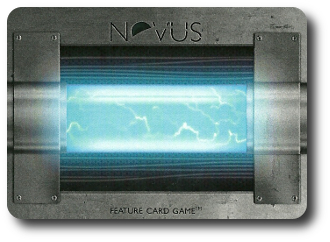
The player should now count the total number of face-down cards they have in their Resource Zone. The player should also scan their playing area for any Location cards that might provide energy. The values are totaled and the resulting number is the amount of energy the player has in their pool to use for their turn. This energy will be used to play cards and trigger abilities. It might help for a player to take a number of counters equal to the energy they have and “spend them” to help keep track of where their energy is going and how much they have left.
Standby Phase
This phase triggers the abilities of any cards that state they take place at the beginning of the player’s turn or during the Standby phase. The only other action the player can take is playing Tactic cards from their hand if the total amount of energy the player has allows it. Place the Tactic card to one side of the discard pile if its effects are resolved in a later phase or place it immediately in the discard pile if the effects are triggered and resolved upon being played.
Main Phase
Now the player comes to the most complicated and involved phase of the game. This phase allows for multiple deployments and combat. What the player does is dependent not only on what cards they have in play and in their hand, but also what they want to accomplish on their turn. As such, we can only discuss this phase in generic terms.
Deploy Characters
Character cards have an energy cost noted on their upper right-hand corner of the card’s face. This is referred to as the “deploy cost”. The player must be able to pay this cost from their energy pool to bring the Character card into play. This reduces the total amount of energy the player has available on their turn. Newly deployed Character cards are placed, face-up, in the player’s Deployment Zone. Characters deployed this turn cannot be used in combat other than to defend.
Enact Strategies and Locations
Location, Strategy, and Tactic cards are not “deployed” as Character cards are. Instead, they are “enacted”. Each Location, Strategy, and Tactic card have an energy cost noted on their upper right-hand corner of the card’s face. This is referred to as the “enact cost”. The concept is the same as a deploy cost, however, enacting does not reduce the player’s overall energy pool. Rather, the enact value of a card is compared against the total energy the player has available. If the player has enough, the card can be enacted, but the player’s overall energy level is not reduced as a result of the card coming into play.
Location cards are played face-up in the player’s Resource Zone and immediately become active and continue to be so as long as they are face-up. Note that not all Location cards provide energy. If they do, they provide their energy to the player’s energy pool.
Strategy cards are also played to the player’s Resource Zone. They come into play face-up. As already mentioned, Tactics are played directly to the discard pile or set aside next to the discard pile until the player’s turn is over.
Once the Location and Strategy cards are in the Resource Zone, they are active, but not triggered unless the player wants them to be and the game play conditions allow it.
Engage in Combat
Players do not directly attack each other. That would expose the players to the world at large and their greatest strength is their anonymity. Instead, the players uses their Commanders as their proxy and guide them to lead their armies. Since the player remains shrouded in secrecy and subterfuge, the Commander is seen as the faction’s leader and is the primary target at all times.
If a card can attack, it has an attack value. If the card can defend, it has a defense value. Only Character cards that have been deployed can be used in combat, but Character cards that were just brought out this turn cannot attack. They can, however, defend.
If a player decides to attack, they move their deployed Character cards to their Combat Zone. The defender then does the same by moving any Characters cards they want to use to defend their Commander to their own Combat Zone.
Combat is done en mass and simultaneously like a real battle. In other words, players do not resolve combat one card at a time, but they can if they so choose. This gives the players the ability to direct their Characters as a group or as individuals. Character cards can only group and defend as one force (adding their defense values together) if they share the same faction. This means that faction specific Characters cannot group with neutral Characters. If the player does defend with a group, they decide how the damage is distributed among their Character cards in that group.
Once the attacking player calculates their attack strength (by adding up all their Character cards’ attack values) and the defending player calculates their defense strength (by adding up all their Character cards’ defense values), the two numbers are compared and damage is assigned by the defending player.
The Character card’s defense value is also its life. If the Character card takes an amount of damage equal to or greater than their defense value, they are sent to the discard pile. Any damage that cannot be redirected and absorbed by the player’s defending Characters is instead transferred to the player’s Commander. The Commander does not have a defense value, however, so the unblocked damage instead reduces the Commander’s morale value. Thematically, this indicates that a battle went so poorly it damaged the player’s cause and the Commander’s perceived authority.
Note that card abilities and effects cannot be triggered during the damage calculation portion of combat unless the ability or effect specifically states that it does. Also, any attacks from a Character with the ranged ability can only be defended against by other Characters with the ranged ability.
Once combat is concluded, any surviving Characters are returned to the player’s Deployment Zone to lick their wounds or to celebrate their victory.
Cleanup Phase
The last phase of a player’s turn is meant to quickly set the game playing area for the next player’s turn.
- All players retire any face-up Strategies in their Resource Zones to their discard pile, as well as place any Tactic cards they might have next to their discard pile.
- Any effects on cards that stated “end of turn” or “during the cleanup step” are triggered and resolved. Order in which they are triggered is up to the player.
- Any remaining energy in the player’s pool is lost and total energy is adjusted for enacting.
This ends the player’s turn. The next player now has their turn starting with the first phase noted above.
Winning the Game
The game continues until one player’s Commander has their morale value reduced to zero or less. Demoralized and broken, the player must retreat to the shadows to reorganize. The battle has been lost, but not the war. And so, the struggle for control continues…
Adding a Personal Touch
While NOVUS will be offered as preconstructed decks, a player is allowed to build their own decks to meet their specific needs. When building your own deck, the following rules must be observed:
- Each deck must be comprised of no more and no less than 50 cards (Commander cards are not counted)
- Faction symbols in the deck must match the player’s selected Commander card
- Neutral cards can be added to any deck, regardless of the Commander card’s faction
- The number of a specific neutral cards must follow the card limits
The rarity of faction cards can be determined by looking at the colored border found around the faction symbol. The rarity only suggests how many of that card can be found in a complete game set. The game set will include common, uncommon, and rare faction cards. The “promotional” rarity value is for those cards that are released as part of demos and at special events.
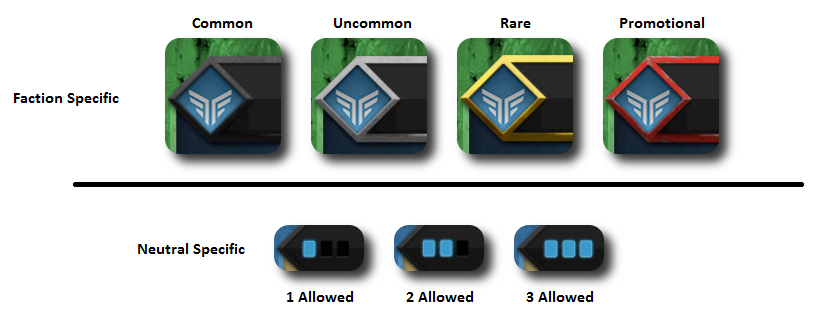
The non-faction neutral cards do not have any faction symbol. Instead, they have “dots”. The dots do not suggest the card’s rarity. Rather, they indicate how many of that specific card can be included in a player’s custom faction deck. For example, the “Targeted Removal” non-faction neutral Strategy card has 2 dots. This means that no more than two of this card can be in a the player’s deck during the game.
This concludes the high level overview of the game and the game play. To learn more about NOVUS and read the full rules, visit the game’s website or visit the Kickstarter campaign.
Prediction
Our groups have had a lot of fun with games like NOVUS in the past, and due to what I perceive to be easy rules and engaging game theme and narrative, I have no doubt the game will be very well received. There is a lot to do in the game, but the intuitive phases help keep track of what must be done and when. The card layout is simple to grasp and the difference between deploying and enacting is a neat twist on traditional resource and hand management games. There is an excellent mix of strategy and tactics to keep the elitists engaged and the artwork will capture the imagination of the Child Geeks. The Parent Geeks are going to love this simply because of how BIG the game feels without really being all that big. In fact, I think NOVUS appears to be a very casual game. This is especially true when we consider how each faction deck is preconstructed and “ready to play” right out of the box. Add that to the light rules, and you’ve got a sure hit on your hands with the Parent Geeks.
The amount of time necessary to teach NOVUS comes down to an individual player’s past game playing experience. You’d be hard pressed to find a Gamer Geek who didn’t, at the very least, understand the concepts found in NOVUS and most Child Geeks will be introduced to the very same concepts for the first time when NOVUS is placed in front of them. Luckily for you, the individual teaching the game, the rules are very light (surprisingly so) and the game play is straight forward. For your most inexperienced players, I predict you will be talking through the game play a great deal just to help them keep track of what is going on. For everyone else, just shuffle and go after the game has been explained.
After teaching the game to my oldest little geek, who has played and can play such games as Dominion, Dragon Clash, Magic: The Gathering, and other games that share common characteristics with NOVUS, I asked him his thoughts on the game so far.
“This looks awesome and it sounds super easy to play. Let’s go, already!” ~ Liam (age 9)
Yes, a very awesome looking game with easy game play…in theory. Let’s put the theory to test and see if we meet with great success or cataclysmic disaster.
Final Word
The Child Geeks who were old enough to play the game simply loved it. They spent way too much time looking at the card illustrations and not enough time reading the card abilities, however. There is a lot of eye candy in NOVUS and more to come. I wouldn’t say the illustrations are distracting (because they certainly are not), but I often had to remind the Child Geeks to “take their turn” when it was obvious they were just looking at the cards instead of thinking about what they should do with them. When the Child Geeks did focus on the game play, they did very well. What cards needed to be played for energy and which should be deployed or enacted seemed to be of little concern for them and their game playing sessions always ended on a very positive note. None of them won against a Parent or a Gamer Geek (obviously), but nor were they slaughtered. Proof, as far as I’m concerned, that NOVUS is very playable by Child Geeks as young as 9-years-old. When the game was put away, all the Child Geeks demanded we get the cards out again so they could look at them. In between excited chatter and discussions regarding the cards, we were able to determine that they fully approved the game.
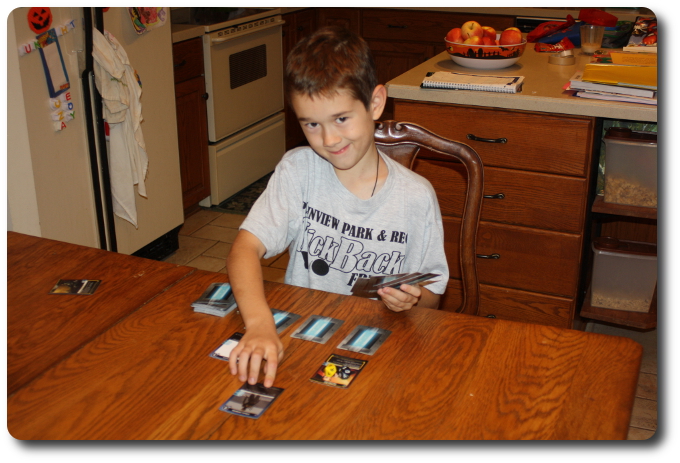
Only 2 minutes into the game and my little geek makes the first attack! What impertinence!
The Parent Geeks really enjoyed the game and thought it was “just what they were looking for” in some cases. As you might or might not know, Netrunner is all the rage at the moment. Netrunner is set in the future and shares a number of similar theme elements found in NOVUS, although I think NOVUS is attempting to tell a much bigger and more interesting story. Players have to build their own decks in Netrunner and there are new cards coming out all the time which makes deck-building a complex, involved, and expensive process. I’m speaking from experience here. Many of the Parent Geeks remember playing the original Netrunner and even more are science fiction fans. Unfortunately, very few of the Parent Geeks have the time or wherewithal to enjoy Netrunner. NOVUS is going to be a complete game with no deck-building required, but the player can certainly do so if they wish. This really appealed to the Parent Geeks because the full game would provide 4 different factions, which implies 4 different ways to play. Depending on what faction the player’s opponent selects, game play could be different every time. According to one Parent Geek, “Finally, a science fiction card game I can choose to expand or not depending on how little time I have!” All the Parent Geeks voted to approve the game.
The Gamer Geeks all agreed that what they were presented and played was very good, but not all of them took the next step to endorse it. According to one Gamer Geek, “This is a really good game, excellent rules, and some intriguing game play, but I am not playing the game as it was intended. Nor have I seen the other factions. I cannot and will not endorse a game that I haven’t fully played yet.” The majority of the Gamer Geeks agreed with only a few saying they would approve the game based on what they were provided so far. When I asked them if they wanted to reject the game, they all said no. In response, one Gamer Geek said, “I cannot reject this game because I love what I was shown, but I cannot approve the game either. It’s like you’ve given me a bite of food and then asked me to rate the whole menu. I can’t do that, but I know I like what I have tried so far.” So, in the end, the Gamer Geeks felt very positive and excited about NOVUS, but refrained from endorsing it until such time they have an opportunity to play the game in its entirety.
Personally, I feel cheated. I review prepublished games knowing they are not yet complete and what I am being offered is meant to represent the final product. What I was given didn’t even come close. With only 2 factions – which were the same faction – I didn’t get a good look at NOVUS. In fact, I feel like what I was given was nothing more than a giant tease.
I spent most of my time playing NOVUS feeling kind of ticked off that I couldn’t play with the other factions or explore the deck-building aspect of the game. I can’t even say with a straight face that I test drove NOVUS. I jumped in, turned it on, and put it in first gear for a very short ride down the driveway. And that’s it. I know enough about the game to say without hesitate that “I am very interested and excited to see what will come”, but left bitterly disappointed because I have yet to actually play the game.
Can I recommend NOVUS? No, not really, because I technically haven’t played it yet. NOVUS is meant to be played with different factions. I was giving 2 of the same faction because of a shipping error that could not be corrected. In short, after all the games I have played and observed, I have yet to actually play the game. That’s a bit disheartening, eh?
This journey ends at a crossroads. The highly subjective geek side of me wants to tell you “THIS IS THE GREATEST GAME IN THE WORLD!!”, while the objective reviewer in me wants to tell you that “I haven’t played this game yet”. I choose to be somewhere in the middle. While I highly doubt that anyone who plays the game would dislike it, saying as much is pure speculation on my part.
Simply put, “be interested in the game – be very interested.” That’s about as good as it gets, people, when you are forming an opinion off speculation and intense excitement tempered with cold objective reasoning. I really want to tell you more about this game, but first I really have to play it.
This is a paid for review of the game’s final prototype. Although our time and focus was financially compensated, our words are our own. We’d need at least 10 million dollars before we started saying what other people wanted. Such is the statuesque and legendary integrity of Father Geek which cannot be bought except by those who own their own private islands and small countries.




Cheeky monkey. Great summary of the game…despite the lack of totality.
Yes, my biggest problem with NOVUS is that I didn’t play NOVUS. Of course, that’s a pretty easy problem to fix, just not one I could address in time for the review.
Thanks for reading and taking the time to comment, Mr. Leder!
Cyrus, when, if possible, will you play it? I’ve been following the progress of NOVUS for some time and am looking forward to your review post play.
Thanks for taking the time to read the review and leave a comment, David.
If by “play” you mean with the other factions, I will not be returning to the game to re-write the review until after the game has been published. I have a small room full of games that need my attention and I cannot spare anymore time on NOVUS.
As always, solid review! This gives me a much better idea of how the game is played.
Glad it helps! Thanks for taking the time to read our review and leaving a comment.